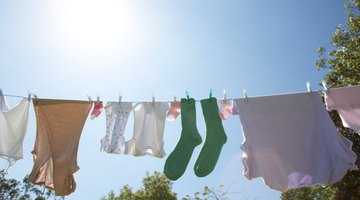How to Remove Mildew From Old Quilts
Vintage quilts need to be handled with care. Although you usually would avoid exposing an old textile to direct sunlight, sunshine is the best way to kill mildew without damaging delicate fibers. Leaving your quilt outside long enough to kill the mildew won't damage the fabric, but ignoring the mildew will.

Once you have removed the mildew, let the quilt dry completely before storing or displaying. Store the quilt in a dark, dry cabinet, or display away from moisture and direct sunlight to protect it from mildew and other damage.
Things You Will Need
- Soft old toothbrush
- Plastic cup
- Warm water
- Baking soda
- White vinegar
- Clean white cotton towel
- 1 cup lemon juice
Tip
If you don't have a clothesline, drape the quilt over a piece of lawn furniture or spread it out on top of a clean, dry blanket on the lawn. Even though vinegar smells when you use it, the scent will dissipate as the quilt dries. A large kitchen sink is big enough to accommodate most vintage quilts, but you could use a bathtub instead.
Warning
Never use bleach on an old quilt; it could permanently damage the fabric. Never machine wash an old quilt; doing so could ruin it.
-
Spread the quilt on a tabletop or large work surface. Look at the quilt surface and identify the areas that have mildew.
-
Fill the plastic cup with warm water. Dip the toothbrush in the cup and then into the baking soda. Use enough baking soda to coat the brush bristles completely.
-
Gently brush each mildew spot with wet baking soda. The soda will combine with the water to form a paste that is of toothpaste consistency. Dip the toothbrush in the warm water and baking soda as needed for each spot.
-
Use the cap from the vinegar to pour a capful of vinegar on top of each of the treated spots. The vinegar and baking soda will bubble; this is a chemical reaction and is normal.
-
Blot the mildew spot with a clean towel to absorb the excess vinegar mixture.
-
Fill the sink with warm water and add 1 cup of lemon juice. Immerse the quilt in the sink. Soak for 10 minutes.
-
Drain the sink. Squeeze the water from the quilt by gently pressing the quilt against the side of the sink. Do not wring the quilt.
-
Hang the quilt to dry outside in direct sunlight. Remove promptly when dry. if your quilt is extremely fragile, don't hang it, just spread it out on top of a clean blanket on the lawn.
The Drip Cap
- Vintage quilts need to be handled with care.
- Leaving your quilt outside long enough to kill the mildew won't damage the fabric, but ignoring the mildew will.
- Store the quilt in a dark, dry cabinet, or display away from moisture and direct sunlight to protect it from mildew and other damage.
- Fill the plastic cup with warm water.
- Gently brush each mildew spot with wet baking soda.
References
- "The Cleaning Encyclopedia", Don Aslett, 1999
- "Sewing with Vintage Linens"; Samantha McNesby, 2003
- "Martha Stewart's Homekeeping Handbook: The Essential Guide to Caring for Everything in Your Home"; Martha Stewart; 2006
Writer Bio
Sarah Emerald is the author of books and magazine articles specializing in crafts, family, business and the home, including Create and Decorate, Hilton Head Monthly and Crafts magazine. She has a Bachelor of Arts in English from a small private college in the southeastern U.S.
Photo Credits
- Martin Poole/Lifesize/Getty Images
- Martin Poole/Lifesize/Getty Images
More Articles



